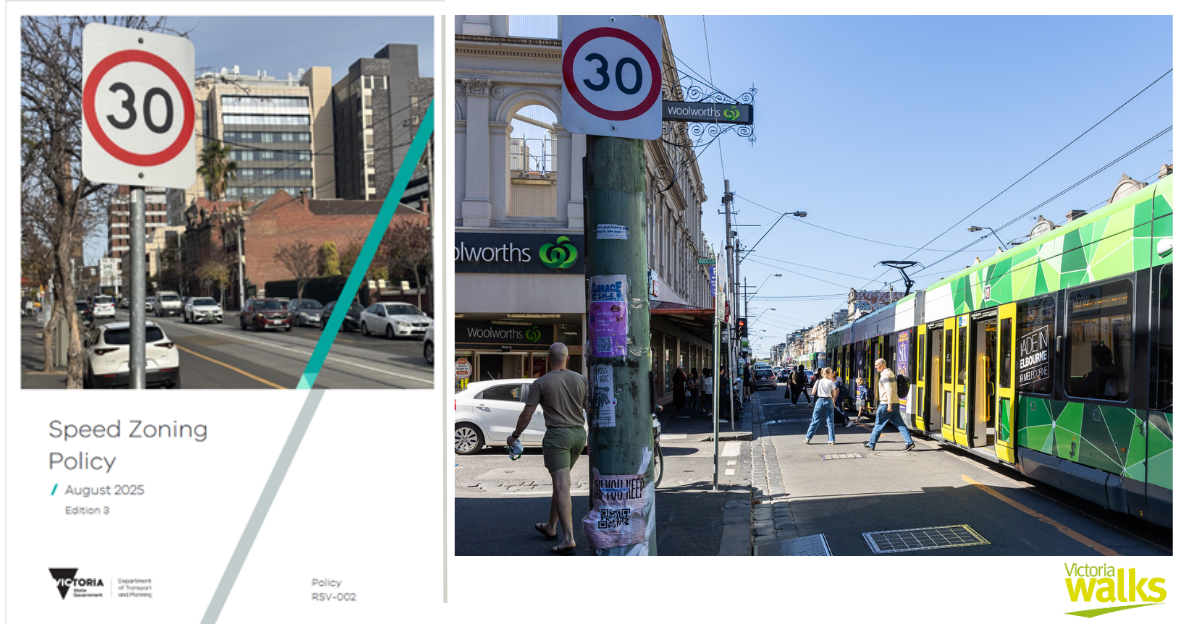Victoria Walks welcomes 30km/h speed policy shift
29 Aug 2025
Victoria Walks CEO Sarah Pilgrim today welcomed a road safety policy shift in Victoria that paves the way for 30km/h streets in areas where lots of people walk, such as near schools and shops.
Earlier this week the Department of Transport and Planning released the first update of Victoria’s Speed Zoning Policy since 2021. The update added 30 km/h as a standard speed limit that can be applied in particular settings by council and state government road managers, among other changes.
Victoria Walks has been advocating for this change for more than a decade, along with many local government organisations and road safety bodies.
Our 2011 submission to a speed limit review called for 30 km/h in high volume pedestrian areas, such as the Melbourne CBD and busy shopping strips.
Our 2016 report ‘Safer Road Design for Older Pedestrians’ recommended the Victorian Government give councils ‘capacity to apply 30 km/h speed limits’ to bring down deaths and injuries and to encourage more walking.
Responding to the policy shift Sarah Pilgrim said councils and communities across Victoria had been given a powerful, evidence-supported tool to create safer and more pleasant streets for people of all ages and abilities.
“With safer 30km/h speeds there are fewer crashes, and fewer near misses,” Ms Pilgrim said. “I hope to see many communities reaping the benefits of neighbourhood streets that feel safer for walking, for accessing local services and for connecting with friends and community.”
The Department of Transport and Planning will still need to approve speed zone changes.
Victoria Walks particularly welcomes the new policy’s guidance on speed zones in school neighbourhoods. Streets around schools (within 200 metres of a school boundary) are now encouraged to be 30 or 40 km/h.
This is an improvement on the current policy of variable 40km/h school zones, which only offers safer speeds to children near the school gate and only at drop-off and pick-up times.
There is also scope in the new policy to apply 30km/h on particular routes within the broader school catchment (beyond the 200m).
Until now, councils have only been permitted to trial 30km/h rather than apply it as a permanent speed.
This has meant inner-city councils such as City of Yarra have had to seek repeated approval to create 30km/h trial areas, despite this speed being globally recognised as the most appropriate for streets where high numbers of walkers mix with vehicles.
“At safer speeds it is easier for drivers to see people,” Ms Pilgrim said. “It’s easier and safer to cross streets – particularly for children, older adults and people with disability.” \
Tragically 38 people have been killed on Victoria's roads while out walking so far in 2025, compared to 33 at the same time last year.
This is in keeping with an upward trend in road trauma in recent years, with people who travel outside vehicles (walkers and people riding bikes and motorbikes) taking the brunt of growing risks on Victoria's roads such as larger vehicles.
A simple way to quantify the impact of safer speeds is by fatality risk.
Walkers who are struck by a vehicle moving at 30km/h have a 90% chance of survival. The chance of survival drops to 60% if the walker is struck by the vehicle at 40km/h. If struck at Victoria’s current default speed limit of 50km/h, a healthy adult walker has just a 10% chance of surviving the impact.
Sarah Pilgrim said the speed zoning policy shift sent an important signal that safety for vulnerable road users must be a stronger consideration in Victoria’s transport planning.
Read the story in The Age.
For media comment about the new speed zoning policy and its implications for pedestrian safety please contact Sarah Pilgrim at infoATvictoriawalks.org.au (replace AT with symbol).